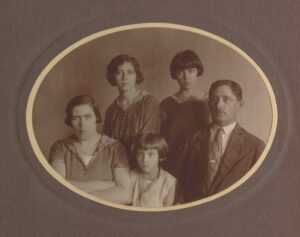, Writing for Newspapers. IMS Clarice Lispector, 2018. Disponível em: https://site.claricelispector.ims.com.br/en/2018/08/22/todas-as-cronicas-de-clarice-lispector/. Acesso em: 06 January 2026.
This August, Todas as crônicas [All the Chronicles] will be released, a volume that brings together for the first time all the texts of the genre written by Clarice Lispector for newspapers and magazines. The edition, organized by Pedro Karp Vasquez, contains 124 articles never published before in book form.
The writer had a longstanding connection with the press. Even before she became known for her books, she had been a writer and reporter for the National Agency, a job obtained through a declaration of love for her country in a letter sent to President Getúlio Vargas. At that time, she did not yet sign the stories. Only a few years later, after launching her first novel, Near to the Wild Heart, did she start to sign her name in O Jornal, owned by her friend Samuel Wainer. In the 1960s, sparingly, she also published short stories and chronicles in Senhor magazine. Distinction as an author of crônicas, however, would come starting in 1967, when she took up a column in the Jornal do Brasil, for which she wrote weekly for six years.
That being said, it may seem that Clarice’s familiarity with the newspaper text has always been peaceful; on the contrary, she showed discomfort more than once with the overly personal tone assumed in the chronicle. In “Fernando Pessoa me ajudando” (Fernando Pessoa Helping Me), for example, she writes:
In the literature of books I remain anonymous and discreet. In this column I am in some way letting myself be known. Am I losing my secret intimacy? But what to do? It’s just that I’m writing at the typewriter’s pace [ao correr da máquina] and, when I look up, I’ve revealed a certain part of myself.
The difference between “writing for newspapers and writing books” was still a reason for reflection in the chronicle of the same name: “In a newspaper one can never forget the reader, whereas in books one speaks more freely.”
Clarice was always apprehensive about signing her name indistinctly in one medium and another. Therefore, in the three experiences in which she was at the head of columns dedicated to the female public, during the 1950s and 1960s, she preferred to protect herself under three different female names: Tereza Quadros, Helen Palmer, and Ilka Soares. Distrust of newspapers also included writing for money. However, despite feeling as if she were “selling her soul,” as she once confessed, Clarice built a columnist’s oeuvre that is now placed on the same level as the short stories – as proves the edition of Todas as crônicas in a single volume, with the same graphic design of Todos os contos, released in 2015.
Todas as Crônicas is divided into three parts. The first and most extensive encompasses the chronicles written for the Jornal do Brasil, which had previously been compiled in A descoberta do mundo (Discovering the World). In this first edition, sixty texts were left out. This was due to the fact that, in the space reserved for the column, the writer sometimes published different independent fragments instead of a single text; in these cases, some were chosen over others. This new edition fills this gap. And, according to the organizer, it is now possible to discover, for example, Clarice’s opinion about some important writers, such as Rubem Braga, Nelson Rodrigues, Jorge Luis Borges, and Gabriel García Márquez, among others.
The second part presents texts from Senhor and Joia magazines and the newspapers Última Hora and O Jornal that had never been published in a book. The selection is the result of research by Larissa Vaz in the archives of the Moreira Salles Institute, the National Library, and the Rui Barbosa House Foundation. The third part, finally, reproduces the chronicles extracted from the section called “Back of the Drawer,” originally published as part of the storybook The Foreign Legion, and later collected in Not to Forget.
An interesting fact is that, among the chronicles published by the author throughout her life, many were reused in different versions or simply repeated (from the collection of stories to the periodical or from the periodical to the book) with intervals that sometimes reached more than a decade between one and the other. This shows that, despite the author’s harsh judgment, there did not seem to be such a clear line between “writing for newspapers and writing books.” In addition, the newspaper also served Clarice as a space for her work in progress, in which she published embryonic texts that would take a refined form in future tales and novels, as is the known case of An Apprenticeship or The Book of Delights, wherein almost entire passages could have been previously read in the pages of the Jornal do Brasil.
One difference is clear: the newspaper’s deadline imposed on the writer the rhythm of a “typewriter’s pace,” hence the often proclaimed fear of being rudimentary. But, as is well known, Clarice was not a predictable person. In the midst of the recurring complaints, there was always a lucid acceptance of what caused her discomfort with the quick text, because, intimately, she was likely to feel it as a means of experiencing the limits of her writing. In view of this, the same writer who declares “I’m very demanding of myself” or “I’m afraid: writing a lot and all the time can corrupt the word” also confesses to being “fond of the unfinished, the poorly made, that which awkwardly attempts to fly and falls flat on the ground.”
Clarice talked a lot about how the public loved the chronicles. Since she started writing for the Jornal do Brasil on Saturdays, she also received a great deal of affection from the newspaper readers, who filled the newsroom with letters. She sincerely rejoiced:
I’m a happy columnist. I wrote nine books that made many people love me from a distance. But being a chronicler has a mystery that I don’t understand […] it has brought me even more love. I feel so close to whoever reads me.
Somewhere between the newspaper and the book, Clarice seems to be addressing issues dear to her lonely but loving personality, her hermetic but seductive writing. It is not by chance that in her fiction the everyday fact is the raw material from which a “state of grace” can be revealed, a notion that was developed by the author herself in a chronicle of the same name and that finds correlates in terms such as “exemplary instant,” “existential moment,” “amazement,” “flash,” “instant-now,” which are found in her work.
Therefore, Todas as crônicas, more than placing her books and newspaper texts on equal footing, in a diptych and alongside Todos os contos, reveals the sum of Clarice’s work, which is situated on the fine line between the ordinary and the sublime.







